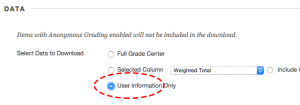Challenge (Beth Ann Cooke-Cornell): Gradebook versus Excel
In Excel can have a different formula for each student to accommodate those individual circumstances, can drop the lowest two quiz grades easily, have multiple grading sheets that are readily available, have all the assignments listed at the top and and a clean sheet with just numbers and dropped quiz grades and extra credit, and can’t upload Excel spreadsheets or columns to Bb.
Part I: Grade with Excel, upload to Blackboard
If using Excel is the best option for you to calculate grades by leveraging Excel’s unique capabilities, you can upload a file from Excel to Blackboard. You can’t, however, upload an Excel file. The best procedure for using Excel with Blackboard is to download the student information from Blackboard and then periodically save comma-separated-values (CSV) files and uploading those to Blackboard.

Grade Center Work Offline Contextual menu
First, download the student information by clicking on the work offline contextual menu and selecting “Download”:

Select User Information only
Next, in the download Grade Center page, select “Student Information Only” from the data options:
Under file type, select tab-delimited for an Excel formatted file. (Remember, you need to upload a csv file to Blackboard but you can use an xls file in Excel to calculate grades.)
Select “My Computer” as the save location and click the “Submit” button to create the download file. On the next page, click on the download button and note where the file is saved on your computer.
You can now use the Grade Center Excel file as you use any Excel file, including formulas. Remember, however, to leave the information in the file when you download it intact. Blackboard needs the student information in the same format when you upload the grade data.

Select Comma-Separated Values (.csv)
Before saving for upload, save the file in Excel format. To save the file for upload to Blackboard, select “Save as” from the file menu in Excel. Choose comma-separated values (csv) for the file type and save. When Excel asks do you really want to save in this format, choose yes/continue.
The csv file is a one use only file that you can delete when you’ve uploaded the column(s) that you’ve updated. If prompted to save the file before exiting Excel, make sure you’re saving as an xls or xlsx file to retain formulas.
Upload the csv file: To upload the file with new grade columns, select “Upload” from the Work Offline contextual menu. When prompted, browse to the file and select it. Click the submit button and you will be prompted to confirm which columns to upload:

Upload Grades page
By default, every column that is new will be selected. If you have some columns you don’t want uploaded, deselect them before submitting.
When you return to the Grade Center, scroll to the right to see the new columns and the grades that have been added.
More information on grading offline can be found on the Blackboard Help site.





